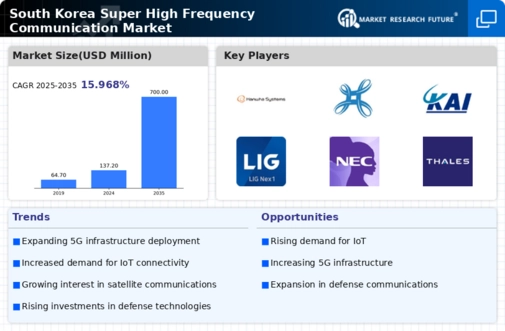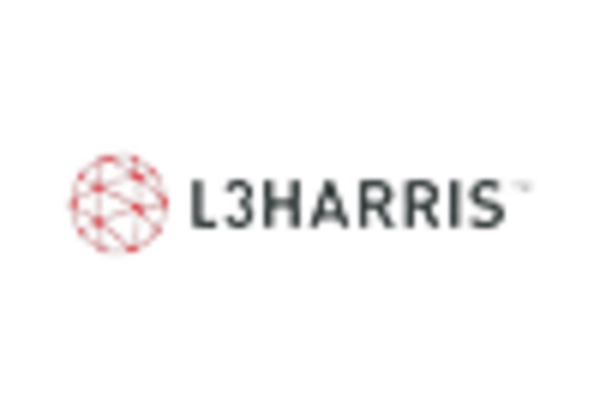Emergence of 5G Technology
The emergence of 5G technology is a pivotal driver for the super high-frequency-communication market. South Korea has been at the forefront of 5G deployment, with widespread adoption expected to reach 80% by the end of 2025. This rapid rollout of 5G networks is likely to create a substantial demand for super high-frequency communication solutions, as these technologies are essential for maximizing the potential of 5G. The increased data rates and lower latency associated with 5G are expected to enhance user experiences across various sectors, including entertainment, healthcare, and transportation. Consequently, the super high-frequency-communication market is poised for growth as businesses and consumers seek to leverage the benefits of this advanced technology.
Focus on National Security and Defense
The focus on national security and defense is a critical driver in the super high-frequency-communication market. South Korea's strategic position in a geopolitically sensitive region necessitates robust communication systems for defense purposes. The government is likely to allocate substantial resources to enhance communication capabilities within the defense sector, with investments projected to increase by 20% in 2025. This emphasis on secure and reliable communication systems is expected to drive demand for super high-frequency solutions, as they offer enhanced security features and resilience against potential threats. As national security remains a priority, the super high-frequency-communication market is anticipated to experience growth fueled by defense-related investments.
Growing Adoption of Smart Technologies
The growing adoption of smart technologies is influencing the super high-frequency-communication market. As South Korea embraces the Internet of Things (IoT) and smart devices, the need for efficient communication systems becomes paramount. In 2025, it is projected that the number of connected devices in South Korea will exceed 50 million, creating a substantial demand for high-frequency communication solutions. This trend suggests that businesses will require advanced communication systems to manage and transmit data effectively across various devices. The super high-frequency-communication market stands to benefit from this surge in smart technology adoption, as it provides the necessary infrastructure to support seamless connectivity and data exchange among devices.
Rising Demand for High-Speed Data Transmission
The increasing need for high-speed data transmission is a primary driver in the super high-frequency-communication market. As South Korea continues to advance in digital infrastructure, the demand for faster and more reliable communication systems is evident. The proliferation of data-intensive applications, such as streaming services and cloud computing, necessitates robust communication solutions. In 2025, the market is projected to grow by approximately 15%, driven by the need for enhanced bandwidth and reduced latency. This trend indicates that businesses and consumers alike are seeking superior communication capabilities, thereby propelling the super high-frequency-communication market forward. The integration of advanced technologies, such as 5G, further amplifies this demand, as it enables unprecedented data speeds and connectivity options.
Increased Investment in Telecommunications Infrastructure
Investment in telecommunications infrastructure is a significant driver for the super high-frequency-communication market. South Korea's government and private sector are actively investing in upgrading existing networks and deploying new technologies. In 2025, it is estimated that investments in telecommunications infrastructure will reach approximately $10 billion, reflecting a commitment to enhancing communication capabilities. This influx of capital is likely to facilitate the development of advanced communication systems, including those operating at super high frequencies. As infrastructure improves, the super high-frequency-communication market is expected to expand, providing businesses with the tools necessary to meet the demands of a digital economy. Enhanced infrastructure not only supports existing communication needs but also paves the way for future innovations.

















Leave Comment